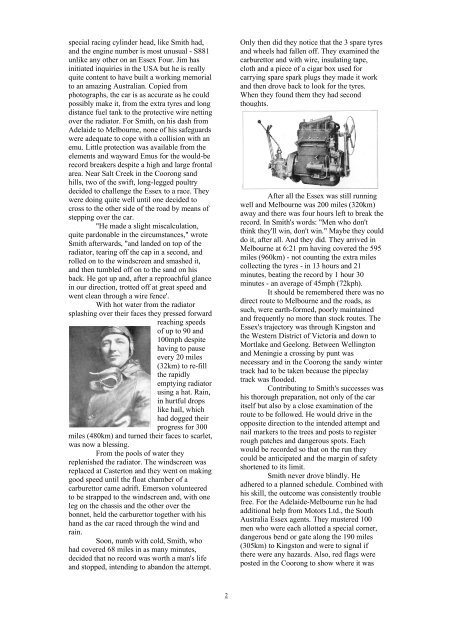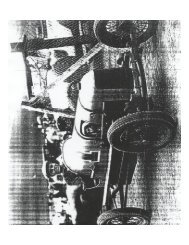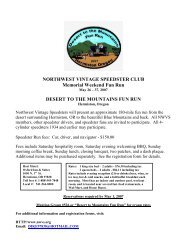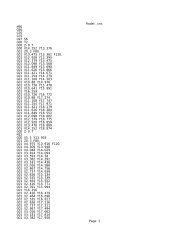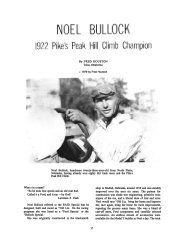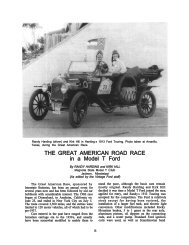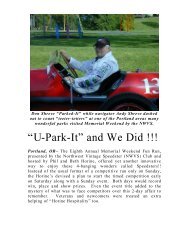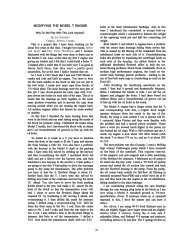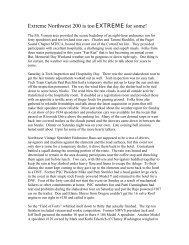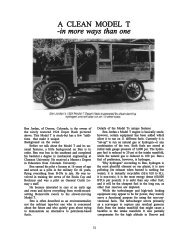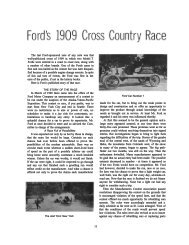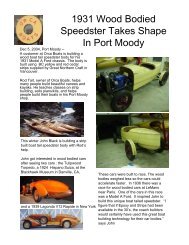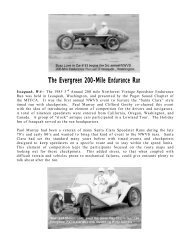Create successful ePaper yourself
Turn your PDF publications into a flip-book with our unique Google optimized e-Paper software.
special racing cylinder head, like Smith had,<br />
and the engine number is most unusual - S881<br />
unlike any other on an Essex Four. Jim has<br />
initiated inquiries in the USA but he is really<br />
quite content to have built a working memorial<br />
to an amazing Australian. Copied from<br />
photographs, the car is as accurate as he could<br />
possibly make it, from the extra tyres and long<br />
distance fuel tank to the protective wire netting<br />
over the radiator. For Smith, on his dash from<br />
Adelaide to Melbourne, none of his safeguards<br />
were adequate to cope with a collision with an<br />
emu. Little protection was available from the<br />
elements and wayward Emus for the would-be<br />
record breakers despite a high and large frontal<br />
area. Near Salt Creek in the Coorong sand<br />
hills, two of the swift, long-legged poultry<br />
decided to challenge the Essex to a race. They<br />
were doing quite well until one decided to<br />
cross to the other side of the road by means of<br />
stepping over the car.<br />
"He made a slight miscalculation,<br />
quite pardonable in the circumstances," wrote<br />
Smith afterwards, "and landed on top of the<br />
radiator, tearing off the cap in a second, and<br />
rolled on to the windscreen and smashed it,<br />
and then tumbled off on to the sand on his<br />
back. He got up and, after a reproachful glance<br />
in our direction, trotted off at great speed and<br />
went clean through a wire fence'.<br />
With hot water from the radiator<br />
splashing over their faces they pressed forward<br />
reaching speeds<br />
of up to 90 and<br />
100mph despite<br />
having to pause<br />
every 20 miles<br />
(32km) to re-fill<br />
the rapidly<br />
emptying radiator<br />
using a hat. Rain,<br />
in hurtful drops<br />
like hail, which<br />
had dogged their<br />
progress for 300<br />
miles (480km) and turned their faces to scarlet,<br />
was now a blessing.<br />
From the pools of water they<br />
replenished the radiator. The windscreen was<br />
replaced at Casterton and they went on making<br />
good speed until the float chamber of a<br />
carburettor came adrift. Emerson volunteered<br />
to be strapped to the windscreen and, with one<br />
leg on the chassis and the other over the<br />
bonnet, held the carburettor together with his<br />
hand as the car raced through the wind and<br />
rain.<br />
Soon, numb with cold, Smith, who<br />
had covered 68 miles in as many minutes,<br />
decided that no record was worth a man's life<br />
and stopped, intending to abandon the attempt.<br />
Only then did they notice that the 3 spare tyres<br />
and wheels had fallen off. They examined the<br />
carburettor and with wire, insulating tape,<br />
cloth and a piece of a cigar box used for<br />
carrying spare spark plugs they made it work<br />
and then drove back to look for the tyres.<br />
When they found them they had second<br />
thoughts.<br />
After all the Essex was still running<br />
well and Melbourne was 200 miles (320km)<br />
away and there was four hours left to break the<br />
record. In Smith's words: "Men who don't<br />
think they'll win, don't win." Maybe they could<br />
do it, after all. And they did. They arrived in<br />
Melbourne at 6:21 pm having covered the 595<br />
miles (960km) - not counting the extra miles<br />
collecting the tyres - in 13 hours and 21<br />
minutes, beating the record by 1 hour 30<br />
minutes - an average of 45mph (72kph).<br />
It should be remembered there was no<br />
direct route to Melbourne and the roads, as<br />
such, were earth-formed, poorly maintained<br />
and frequently no more than stock routes. The<br />
Essex's trajectory was through Kingston and<br />
the Western District of Victoria and down to<br />
Mortlake and Geelong. Between Wellington<br />
and Meningie a crossing by punt was<br />
necessary and in the Coorong the sandy winter<br />
track had to be taken because the pipeclay<br />
track was flooded.<br />
Contributing to Smith's successes was<br />
his thorough preparation, not only of the car<br />
itself but also by a close examination of the<br />
route to be followed. He would drive in the<br />
opposite direction to the intended attempt and<br />
nail markers to the trees and posts to register<br />
rough patches and dangerous spots. Each<br />
would be recorded so that on the run they<br />
could be anticipated and the margin of safety<br />
shortened to its limit.<br />
Smith never drove blindly. He<br />
adhered to a planned schedule. Combined with<br />
his skill, the outcome was consistently trouble<br />
free. For the Adelaide-Melbourne run he had<br />
additional help from Motors Ltd., the South<br />
Australia Essex agents. They mustered 100<br />
men who were each allotted a special corner,<br />
dangerous bend or gate along the 190 miles<br />
(305km) to Kingston and were to signal if<br />
there were any hazards. Also, red flags were<br />
posted in the Coorong to show where it was<br />
2


